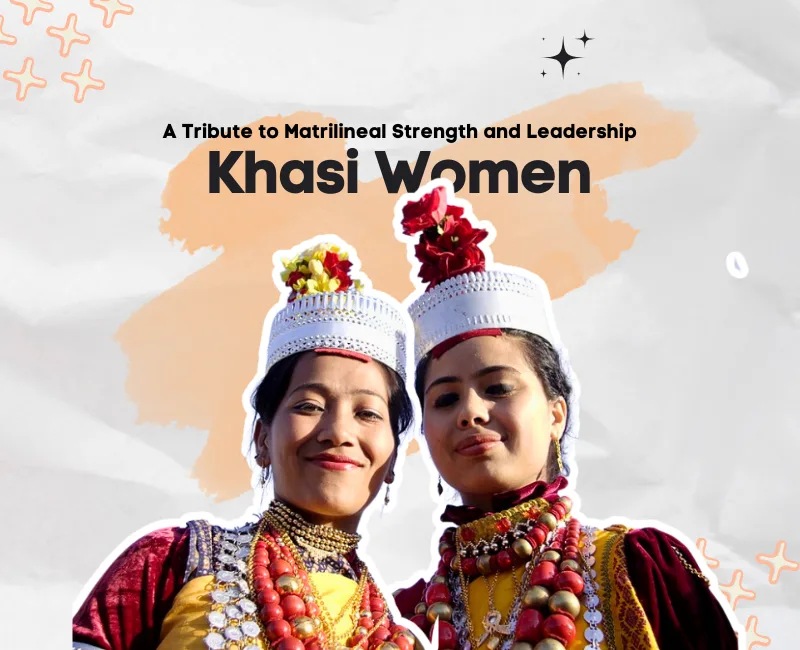Khasi Women- A Tribute to Matrilineal Strength and Leadership

For centuries, the world has largely been shaped by patriarchal systems where sons get prominence over daughters. However, there are remarkable exceptions, where women hold the reins of power and act as a guiding force. One such society is found in the picturesque hills of Meghalaya, India, called “the Khasi Tribe”. This tribe follows the matrilineal culture where the lineage and inheritance flow through the mother’s side, granting daughters a dominant role in family and community life. They have broken the typical norms, giving women the freedom and complete control over their lives and businesses. There are very few matriarchal societies in the world, and Khasi is one of them. Let’s explore some more interesting and motivating things about the Khasi Women and understand how they are a tribute to strength and leadership.
Defining a Khasi Woman: Cultural Significance and Identity
Khasi women belong to a matrilineal tribe in Meghalaya, where lineage and inheritance pass through the mother. As per Wikipedia and other sources, the definition of a Khasi woman is “the guardian and preserver of the family goods” A Khasi woman is the flag bearer of the home and a pillar of strength, leadership and resilience. Their identity is deeply rooted in their culture and traditions. She inherits the matrilineal values of her tribe, balancing the family duties, business and culture. Khasi tribe women’ identity is linked to her cultural practices, traditional attire, and the values that define their tribe.
Khasi Woman’s influence goes beyond her family, shaping the collective identity of the community. She preserves the tribe’s traditions and passes down values, customs, and stories to the next generation. They are the primary decision-makers of the family and caretakers of this tribe’s culture. In a nutshell, Khasi women are the leaders, educators, and protectors of the Khasi community’s identity and culture.
The Origin of the Khasi Tribe
The Khasi tribe has made a significant contribution to the history, economy and development of Meghalaya. They make up a significant portion of Meghalaya’s population. However, till today, it’s unclear how this tribe emerged in Meghalaya. According to speculations, they have lived in the state for approximately 56,000 years. Some scholars believe their origins date back approximately 60,000 years when they separated from the larger group of Austro-Asiatic people.
Anthropologists have discovered that their physical characteristics are similar to those of people in South Asia, including Cambodia, China, Myanmar, and Laos. Linguists believe that the Khasi language is related to the Austro-Asiatic family, which is spoken in many regions of the world, including the Easter Islands in South America. Additionally, the Khasi people refer to the northern mountains as ‘Ki Lum Makashang,’ while the rest of the world calls them the Himalayas. This implies that their forefathers may have arrived somewhere from the north and eventually settled in the Khasi and Jaintia Hills.
There are some books about Khasi women, like Khasi Matrilineal Society: The Paradox Within, Gender, Matriliny, and Entrepreneurship: The Khasis of North-East India, and Matriliny among the Khasis: A Study in Retrospect and Prospect. These books delve more into Khasi women’s origin, lifestyle, values, and traditions.
Khasi Women’s Dress: A Reflection of Their Heritage
The traditional dress of Khasi women is a beautiful reflection of their heritage and culture. Khasi women’s dress is known as “The Jainsem”, comprising a large piece of cloth draped around the body to give it a cylindrical shape. It features a full-sleeved blouse with lacework around the neck and two rectangular embroidered cloth pieces with gold threads. The dress of Khasi women is often complemented with a cotton shawl known as the tap-moh khlieh. The women wear the traditional dress along with gold and silver ornaments during special occasions, events and festivals. Their accessories include a red coral and bead necklace, golden earrings, and a crown made of silver threads at the back. The older women also wear Jainkup, which is a garment made of woolen cloth. The traditional Khasi women’s dress symbolizes their connection with their ancestry and community.
The Matrilineal System: A Foundation of Strength
Unlike the patriarchal systems present in many parts of the world, the Khasi tribe practice a matrilineal system. In this, the lineage and inheritance are traced through women, and they show dominance in society. The main aspects of the matrilineal system are:
- The youngest daughter, known as the ‘Ka Khadduh, ‘ inherits the ancestral property and becomes custodian of the business instead of the sons.
- The children take their mother’s surname instead of their father, which generally happens in the rest of the world. Also, after marriage the husband also takes up the surname of the wife.
- After marriage, not women but the men live in their mother in law’s home. This means the woman stays in her home even after marriage and manages both family and business.
- The market is dominated by independent female vendors who have entire control and responsibility for their businesses.
- Khasi women hold custody of all properties, including real estate, family jewels, and the highest priestly office.
However, it’s not just about the inheritance of property; it embodies women as a crucial part of the community. Their place and essence are not just as the nurturers but also as the protectors and leaders. The Khasi tribe women are the torchbearers of the cultural identity who preserve and pass on the preservation of culture to generations. This community considers women as the cornerstone of the family and the society.
If ‘Ka Khadduh’ dies without daughters, her older sister inherits the family property, followed by the youngest daughter of that sister. If there are no daughters or female heirs, the property passes to the mother’s sister, then to her daughter, and so on. Since the property is ancestral, Ka Khadduh needs approval from her uncles and brothers to sell or transfer it.
The only area that is male-dominated in the Khasi tribe is politics. Khasi women have no power, position, or control in the political system of the village, territory, or state.
Role of Khasi Tribe Women in Family and Society
Khasi women are seen as the backbone of the society and community. From their family to society as a whole, they oversee everything gracefully and perfectly. There are some books about Khasi women that define how they hold a central role in the family structure. They are celebrated not only for their roles within families but also for their contributions to broader society. The main role of Khasi tribe women in family and society is:
Custodian of Ancestral Property
Khasi tribe women are the custodian and caretakers of ancestral property instead of the men. The youngest daughter of the family (known as “Ka Khadduh”) inherits the ancestral property and maintains the family lineage. She fulfils the responsibilities related to the household and preserves the family’s legacy and property.
Caretakers and Decision Makers
Khasi women manage the family and business, maintaining a proper balance between the two. They oversee household duties and family finances, nurture children, and maintain familial bonds. They also act as mediators in the family and resolve disputes, ensuring peace and harmony in the family.
Preservers of Tradition and Cultural Identity
Khasi tribe women are the preservers of their tradition, cultural identity, and spiritual values. They pass on information related to their culture and traditions to the next generation, ensuring the continuity of the rituals and community practices within the family. From Khasi women’s dress to festivals, responsibilities, and values, they ensure that every piece of information is passed down to their kids.
Economic Contributors
Apart from family, they play a prominent role in business and trade. Khasi Women are active participants in commerce and the economy by practicing market leadership and entrepreneurship. Many marketplaces, such as the Iewduh (Bara Bazaar) in Shillong, are dominated by women vendors. In urban areas, they excel as entrepreneurs, running businesses and dominating marketplaces. They play a major role in sustaining the local economy by engaging in farming, weaving, and small-scale businesses.
Contributors in Agricultural Activities
In rural areas, Khasi women actively participate in agricultural activities like farming, raising livestock, and managing natural resources. They contribute to crop cultivation by preparing the land, planting seeds, supplying water to crops, and applying fertilizers. They also collect mature crops and sell them in the local market and cooperatives to run their house.
Education and Career Growth
Modern Khasi women are pursuing higher education and professional careers, expanding the horizons of their work. They are stepping beyond their traditional roles and excelling in diverse fields like law, accounting, medicine, and governance. Many Khasi women take up the role of educators, social workers, administrators, and counselors, contributing to the community’s development.
How Khasi Tribe Women are Balancing Tradition and Modernity
Khasi women take pride in their matrilineal system but face new challenges in today’s modern world. Globalization, economic pressure, changing societal norms, modern influences, etc., have introduced new complexities in their life. These challenges test their balance between preserving traditions and embracing change. The matrilineal system cannot entirely shield them from such challenges, but the Khasi women are fearlessly dealing with it. They remain resilient and adapt to the changes while preserving their culture, traditions and rights.
More and more Khasi women are adopting higher education and skills to enter new fields and industries. They are stepping into urban areas and fields like medicine, law, education, technology, management, etc. Moreover, they are breaking the barriers and creating education opportunities for the next generation also. There are many books about Khasi women that share their stories of resilience while staying connected to their roots.
With modernization, the need to safeguard the cultural identity, rights and heritage of the Khasi tribe women arises. A bill to protect Khasi women from outsiders named” the Khasi Hills Autonomous District (Khasi Social Custom of Lineage) Act” was passed in 2018. This bill aims to protect Khasi women and preserve their rights and heritage in a rapidly changing society.
Khasi Women perfectly balance tradition and modernity in this contemporary world. With knowledge, skills, and awareness, they fiercely navigate the changing dynamics without losing the essence of their roots. They fulfil their role in society without overlooking their families, which makes them the epitome of resilience, balance and strength.
Conclusion
Khasi tribe women are the epitome of resilience, leadership and power. When the whole world follows patriarchal systems, the Khasi tribe follows a matrilineal system in which women have dominance in the community. The youngest daughter inherits the ancestral property; the children take the mother’s surname, and the husband shifts in the in-law’s house. Very few communities are present today where these traditions are practiced. The Khasi women are the decision makers of the home as well as the society as a whole. They excel in every area, from managing business and family to preserving culture and traditions. Its traditions and rituals are completely opposite to those of the rest of the male-dominated world. At last, we can say that Khasi tribe is a live example of how a woman can balance her household and the business together perfectly.


